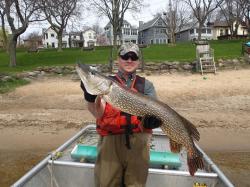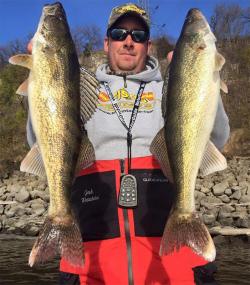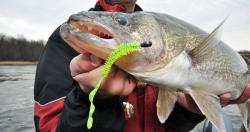Hook tweaks help Rapala pro Ott Defoe win Bassmaster tournament
Tweaking your hook set-ups can improve hook-up ratios and put more fish in the boat. Such was the case last week for Rapala pros Ott DeFoe and Seth Feider, who respectively won and placed second in a Bassmaster Elite Series tournament on the Mississippi River near La Crosse, Wis.
A new hook set-up and new knot helped DeFoe beat 106 of the best anglers on the planet and win his first regular-season, full-field Bassmaster Elite Series tournament. For Feider, a new take on a classic bassin’ rig put fish in the boat when it counted, rewarding him with his highest-ever finish in two years on the Elite tour.
Although DeFoe and Feider fished in different areas with different techniques, the Rapala family of brands contributed key elements to their success, including VMC hooks and terminal tackle, a a Storm topwater bait and Sufix fishing line.
Swim a Treble
Fifteen of the 20 fish DeFoe weighed for a four-day winning weight of 62 pounds, 7 ounces came from a well-known community hole below a low-head dam’s spillway. Although many other competitors fished in the area also, DeFoe caught more bass there than anyone else by throwing a soft-plastic swimbait with a non-traditional hook set-up.
Rather than rigging the swimbait with a weighted swimbait hook or swimbait jig head – as he most often would do – DeFoe fished it weightless, armed with a treble hook. The way cavitating current in the spillway was causing bass to bite led to DeFoe’s decision.
“In this particular situation, the hook-up ratio can be considerably better with a treble hook,” he explains. “When smallmouth in current come up under a bait to bite it, they have a tendency to just slap at it. So an exposed No. 1 treble hook back there, rather than just a single hook, can really help land more of those fish.”
Forged from the finest high-carbon steel, VMC Round Bend Treble 1X hooks are the leading choice for lure manufacturers and anglers who value maximum strength and sharpness. Available in a wide size range, VMC’s model 9650 round-bend trebles give savvy anglers multiple options for switching up the hook set-ups on their favorite baits to adjust to unique or changing conditions.
That’s exactly what DeFoe did to catch his spillway smallies, which were suspending in the top two feet of the water column as heavy current – caused by rain upriver prior to the tournament – washed stunned baitfish over the spillway, practically on top of them.
“There were a lot of other guys in here at the beginning, but I’d guess most of them were fishing under the fish, you know, with weighted baits,” he says. “Rigged weightless with a treble hook, that swimbait gives you almost like a topwater bite.”
DeFoe casted upstream and reeled in at the same speed as the current – not faster, not slower. “That’s so important about the retrieve,” he says. “You want your bait moving the same pace that something naturally flowing down through there would be.”
DeFoe caught the tournament’s biggest bass in the spillway late on the second day of the four-day event, a 6-pound, 1-ounce smallmouth that would prove instrumental. After he caught the 6-pounder, he culled a 2-pounder, for a net gain of about 4 pounds. He beat out Feider for first place by only 1 pound, 3 ounces.
Follow these steps to rig a swimbait with a treble hook:
• Using a line-threading tool, run your main line through your swimbait’s nose and down through its body, exiting just short of the middle. “This will end up putting the hook about dead in the middle of the bait,” DeFoe explains. If you don’t have a line-threading tool, he says, a needle or a long, thin-wire hook like a VMC Neko Hook will “do the trick just as well.”
• Attach a VMC split ring to a No. 1 VMC Round Bend Treble 1X hook.
• Tie your line to the split ring.
• Stick one of the treble’s three “arms” up into the swimbait’s body, vertically centered. The other two treble arms will flare out slightly to the sides. “This will keep everything settled on the cast,” DeFoe explains.
New Knot, Same VMC Hook
It was not a new hook, but a new knot that helped DeFoe land keeper largemouths when he was resting his spillway smallmouth.
After swinging and missing on a few bass while flipping grass with a punch rig, DeFoe re-tied his 4/0 VMC Heavy Duty Flippin’ Hook with a snell-type knot. Such a knot creates a pivot point which, when pressured by a hook-set, causes your hook to kick out into a fish’s mouth.
“I actually didn’t have it snelled the first two days,” DeFoe confides. “The first day I did OK – I missed one, but I caught more than I missed. The second day I only had one bite [on it] and I missed it.”
So on the third day that DeFoe re-tied all the VMC Flipping Hooks in his punch rigs with a knot he learned from a fellow competitor. “It’s not exactly a snell knot, but it works similar,” he says. “I don’t actually know the name of it. My roommate [on tour] showed it to me. It’s a similar style knot where your weight pushes down and it kicks the hook out. That really helped my hook-up ratio those final two days.”
To build your own punch rigs, click these links: VMC Heavy Duty Flippin’ Hook, VMC Tungsten Flip’N Weight, VMC Sinker Stops, Sufix 832 Advanced Superline.
DeFoe caught five of the 20 bass he weighed in the tournament by flipping his punch rig into mats of duckweed and coontail in a 100-yard stretch of river on the southern end of Pool 8. All his flippin’ fish were largemouth. Located about 20 minutes downriver from his smallie spot in the spillway, his largemouth spot featured clean water, current and “a really good edge and canopy,” he says. The vegetation was growing in three to four feet along a breakline that fell to about five to six feet.
“Those transition areas – where the depth changes and the grass ends – give bass an edge to follow and move in and out, up and down,” DeFoe explains. “And it makes a very good ambush point. They can tuck up into that canopy, under that shade, and look out into that open water and watch for baitfish. And they can look up shallow in the other direction under that canopy and look for targets to feed on.”
That being said, it pays to locate numerous such spots. “I found a lot of other places that looked very similar, but only one had fish in it,” DeFoe says.
Feider Finesses ‘Em
While Feider found hungry smallmouth around offshore sandbars with a Storm Rattlin’ Chug Bug, he put them in the boat when it counted with a modified Carolina Rig armed with a sticky-sharp 3/0 VMC Extra Wide Gap hook. While most Carolina Rigs feature heavy sinkers and a leader as long as three feet, Feider fashioned a finesse version popular among river rats on the Upper Mississippi river, but less so elsewhere. While it follows the same formula of main line + weight + leader line + hook, the weight is lighter and the leader shorter. This combination allows an angler to not only get bites in brisk river current, but feel those bites and set the hook soon enough. Feider was throwing a 3/8 oz. weight with a 12-inch leader.
“The really short leader is key,” he explains. “You’ll feel and detect bites better. With a long leader like with a traditional Carolina Rig, your bait just gets blown all around by the current.
“That current I was fishing in was running super hard,” Feider continues. “If you’ve got a three-foot leader behind your sinker downstream and the fish eats it, you’re not going to feel him until you move that sinker six feet.”
The short leader also keeps your bait on the sweet spot to which you often must make repeated casts. “You use the sinker to kind of feel around where the best little spot is and then that short leader keeps the bait right where it needed to be,” Feider explains.
Most of Feider’s Day 3 and Day 4 fish came on his modified Carolina Rig, which was anchored by 3/0 VMC Extra Wide Gap hook dressed with a 3 ½-inch green-pumpkin crawfish-profile bait with the claws dyed orange. He used 17-pound Sufix fluorocarbon for both his main line and leader.
Two of Feider’s key Day 3 bass came on another curveball finesse tactic – a drop shot rig.
“I’ve literally only caught two bass on drop shot on that river before the tournament,” Feider says. “That’s not really a traditional bait that guys throw there. But I knew there were still fish there and it was the next logical step in finesse to catch them. I caught two good fish on it and definitely saved my Day 3.”
Feider’s drop shot rig comprised a 3/8th oz. VMC Tungsten Drop Shot Ball Weight and a No. 2 VMC Neko Hook dressed wacky style with a soft-plastic stickworm.
Despite having no track record of successful drop-shotting shallow smallies on the river, Feider tried the tactic after a couple bass slapped at his modified Carolina rig “but didn’t really eat it,” he recalls. “They’d bite the pinchers off my bait, but wouldn’t really get to the hook. So I knew there were still some semi-active fish sitting there. Twenty casts later with the drop shot, I’d get one of them to eat. It had a little bit more subtle look to it.”
Chug ‘Em Up
Feider’s finesse bites came from about 10 or 20 spots he found in practice with a Storm Rattlin’ Chug Bug. Although each spot was different in subtle ways, each featured current seams in one to three feet around sandbars or small islands that are usually above water, but had been recently submerged by influx of upstream rainwater. Feider calls such spots “sand drops.”
“With the water being high, now they had water going over them and that usually creates a pretty nice drop, or hole, around them,” he explains. The location of these holes are given away by surface disturbances familiar to experienced river anglers.
“There’ll be some kind of key feature in the current that puts the fish where they are on the breaks,” Feider explains. “There’ll be a little swirl on it, or two streams will come together hard.”
In the three days of practice that preceded the tournament, Feider targeted these current seams with a Chug Bug in a chrome pattern. “It’s one of the louder poppers there is and I think the fish really like the profile on it too,” he says. “If there were fish there, they would show themselves on that, for sure.”
And not only did the Chug Bug tell him which spots held hungry fish, it showed him which spots held big fish. “I didn’t have to catch ’em to see how big they were, the way they were coming out of the water to hit the bait,” Feider says. “After the first morning of practice, I was committed to those spots. I feel like there’s more 4-pound smallmouth in that river than there are 4-pound largemouth.”





